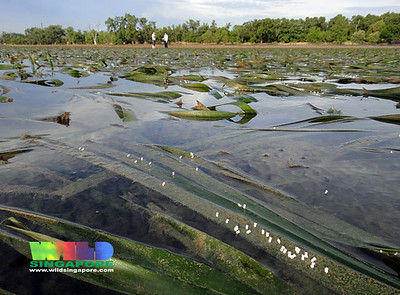We estimate about 20% of hard corals were bleaching and are relieved to see very little recent death, with many large colonies at the reef edge still healthy. Unfortunately, seagrasses remain sparse. Kelvin also flew the drone for unique overviews of the situation.
The rest of team saw all the interesting finds. A small Fluted giant clam (sadly, we couldn't find the others we saw here previously), two large Cushion stars, many nudibranchs and colourful flatworms. I saw a Tiger cowrie! There were lots of fishes, from sharks patrolling the reef edge to razorfish and Frogfish.
 |
| Collage of photos by the team. Links to their albums below. |
Thanks to Kelvin Yong for excellent drone views of the higher shore - no seagrass. As well as reef edge of Pulau Semakau North. Helps confirm the extent of mass coral bleaching - similar to what we saw on foot.
Especially precious is Kelvin's drone overview of the eastern reef edge of Terumbu Raya, as we are unlikely to be able to set foot on this portion during this mass coral bleaching event.
Among those that I saw bleaching were many Trumpet corals, Brain corals and some Branching Horn coral. It was a surprise to see many Anchor corals that were not bleaching. Most of the Carnation corals and plate-form corals I saw were alright too.
I saw large colonies of Acropora corals (not bleaching) and Goniopora corals (mostly not bleaching).
As usual, I saw many mushroom corals at the reef edge. Although there was one cluster of many bleaching bright white, I also came across many large ones of various kinds that seemed alright.
Today, I didn't see many Leathery soft corals on the reef edge. Those I saw seemed mostly alright, only a few were bleaching.
Other cnidarians can also bleach, so I looked out for those too. Bubble-tip anemones are often the first to bleach making them easier to spot, most of them had Tomato anemonefish! I saw one Giant carpet anemones, and two Fire anemones - they were bleaching, and one Magnificent anemone - it was okay, but Kelvin might have spotted one bleaching. I saw many Frilly anemones they were alright. I saw a few tiny patches of bleaching Button zoanthids but most of the Sea mat zoanthids were alright. I didn't see any Asparagus flowery soft corals.
Where there used to be seagrasses, there are large patches of black hairy stuff (cyanobacteria?), brown scum, as well as fine green seaweeds and other seaweeds.
The seagrass situation does not appear to be very different from what I saw at our last survey in Jul 2022, Jul 2020 and Jun 2019. The TeamSeaGrass Site 2 stakes are still there! But there are still virtually no seagrasses at the Site - just scattered Tape seagrass cropped to about 30cm long. I saw sparse sprinkles of various common seagrasses along the mid-water mark. I saw many scattered clusters of longish Tape seagrass (about 30cm) both the old seagrass areas as well as among the reefier edges. There are also good but sparse seagrass growth nearer the reef edge at the northern most point.
This is what the Site used to look like in 2010 just before the seagrasses started to disappear.
More about Pulau Semakau
Just as Changi Airport and Changi Beach are not the same even though they are near one another and share a name, Pulau Semakau is NOT the same as the Semakau Landfill. The Landfill was created by destroying all of Pulau Saking, and about half of the original Pulau Semakau by building a very long seawall. Fortunately, the landfill was constructed and is managed in such a way that the original mangroves, seagrass meadows and reefs on Pulau Semakau were allowed to remain. It is NOT true that the construction of the Landfill created the marine life found on Pulau Semakau. The marine life was there long before the Landfill was built.
What is the fate of Pulau Semakau (North)?
Pulau Semakau (North) is likely to be affected by the massive reclamation outlined recently in the Long-Term Plan Review.
The Singapore Blue Plan 2018
Pulau Semakau and nearby islands and submerged reefs have been recommended by the Singapore Blue Plan 2018 for Immediate Conservation Priority. The Blue Plan recommends the intertidal and subtidal marine areas of Pulau Semakau and adjacent Pulau Hantu, and Pulau Jong to be designated Marine Reserve.
 |
| Photo by Rachael Goh |
DOWNLOAD the Plan, SUPPORT the Plan! More on the Singapore Blue Plan 2018 site.
Photos of others on this survey
Liz Lim
Richard Kuah
Rachael Goh
Tammy Lim
Lon Ong
Tommy Tan
Kelvin Yong
Kelvin Yong drone videos







.jpg)
.jpg)
.jpg)


